Introduction
The fight for civil rights and freedoms is something that has been redefining the history of the United States for many decades. This struggle has made it possible for more people to live in a society that appreciates its freedoms. However, the question of civil liberties has taken a different route in the recent past. Though various laws have been passed to support same-sex marriages in the country, the gay and lesbian rights movement has not received the desirable attention from different stakeholders in society (Andersson et al. 4).
The landmark ruling of the American Supreme Court in Obergefell v. Hodges legalized same-sex marriages. The court issued the ruling in June 2015 to overturn its earlier decision of 1972. Since then, mass media has been used to address the emerging concerns, discontentment, and views presented by many people regarding same-sex marriages. Using the case of Texas, this paper identifies different cartoons published within the past two years to discuss the predicaments associated with the given civil rights concern.
Civil Liberties Issue in Texas: Same-Sex Marriages
Texas is one of the states that have interpreted the Supreme Court’s ruling of 2015 differently when it comes to the question of same-sex marriage. In June 2017, the state’s Supreme Court ruled that same-sex couples were not allowed to receive spousal benefits dispensed by the government (Swartz 3). The state was also finding it hard to strike a balance between religious ideals and the rights of the citizens. Some church leaders were keen to encourage county clerks to avoid issuing marriage licenses to same-sex individuals who were members of different religious groups. They have been arguing that same-sex liberties and religious freedom are unique rights that have been stated explicitly in the nation’s Constitution.
This situation is a clear indication that the fight for same-sex marriage rights is something that has led to divisions among members of the public in Texas. Several cartoons have been observed to analyze the nature of same-sex marriage from a critical perspective. Such works of art have made it easier for more people, scholars, and analysts to understand the most significant achievements so far in the fight for civil liberties (Jervis). The cartoons discussed in this paper are presented below.
Cartoon 1
The first comic uses a satirical approach to analyze the topic of gay marriage. The artist is trying to inform the audience about the rights exercised by different minority groups in the United States. The cartoon reveals the Supreme Court’s ruling of 2015 that permitted same-sex marriages in the country. The artist indicates that the gay marriage issue has already been addressed by the court and is now settled. People in the country should, therefore, stop demonstrating. By means of the cartoon, the artist explains why the state should now focus on the problem of abortion.
This cartoon is effective in terms of conveying the message to the intended audience. The satirical approach informs the audience that the country has made a significant civil rights stride in the area of gay marriage (and same-sex marriage). The important thing is, according to the cartoonist, for the people to focus on other challenges such as abortion (Swartz 6).
Personally, I agree with the position and message of the cartoon. The decision to protest against the rights of same-sex couples, lesbians, and gays is something that should now be abandoned. The outstanding message is that every citizen should be allowed to pursue his or her liberties (Jervis). Americans should now focus on various ethical conundrums affecting them.
Cartoon 2
The second cartoon tries to pass an important message to the targeted audience. It portrays two men whose rights have just been recognized by the county’s superior court. This kind of recognition indicates that it is the proper time to support the rights and liberties of every person in the country. The cartoon reveals that the judges of the Supreme Court are contented with the new situation. Some of the people (or spectators) are rejoicing because of the new recognition (Kelly). Unfortunately, it is evident that the population is divided over the subject of same-sex marriage.
This cartoon is definitely the best method of communicating the message of same-sex marriage rights to the audience. The audience observes that a new dawn has come in the United States. It is clear that the rights of gay people have finally been acknowledged and upheld by the Supreme Court. Additionally, the cartoon shows conclusively that the public remains divided over the matter (Wilson 7). One of the men in the same-sex relationship is happy while the other one is not. Despite this partition, the country has managed to achieve a spectacular goal in its fight for same-sex marriage rights.
The position and message portrayed in this cartoon are acceptable. The artist has managed to present an accurate depiction of the situation as experienced in different states such as Texas. The artist also acknowledges that the divisions displayed by members of the public will continue to dictate the opinions of more people (Swartz 5). The ultimate message, according to the artist, is that those who are unhappy with the new decision should just accept it and move on with their lives.
Cartoon 3
In the third picture, the artist explores how different politicians have analyzed the subject of same-sex marriage in the United States (Kelly). The cartoon portrays a news channel broadcasting the position of Barrack Obama (as a member of the Democratic Party) on same-sex marriage. The two men are amazed by Obama’s stand. The individuals represent two different parties in the country. The position of the Republicans and members of the Tea Party contradicts that of Barrack Obama’s. However, the final conclusion is that same-sex marriage has become a constitutional right that should be respected by all people.
The artist’s approach to using the cartoon to deliver this message is effective. It is agreeable that the audience is informed about the positions of different political parties over the concern. The most significant question is whether more people will be ready to support the rights of same-sex marriages (Andersson et al. 8). Although there are divisions over the topic of gay rights in the country, the cartoonist encourages more people to accept the situation and support those whose rights have been recognized by the Supreme Court.
This position portrayed by the artist is agreeable. The two men do not have a choice but to think about the future (Kelly). It is evident that one of the men is asking the other if he would be willing to marry. This cartoon can, therefore, be used to interpret the situation in the country regarding same-sex marriage.
Cartoon 4
In the fourth cartoon, the artist portrays two men who are in a romantic relationship. The two boys are unable to comprehend the complexity of gay rights. One of the boys is astonished to hear that his friend has two daddies (Wilson 11). This kind of impossibility exhibits the impact of same-sex marriages on the future of every family. The boy is unable to explain why he has two daddies. The cartoonist also indicates that society has come to terms with same-sex marriage. However, the boy’s mother is not presented anywhere in the cartoon. Her absence is the biggest predicament that defines the nature of this new law.
The artist uses the family setting to explore the implications of same-marriage on the integrity of the family. The portrayal of the two men and the boys make it easier for the audience to understand the nature of this discussion. What the artist tries to inform the audience about is that the achievements associated with the same-sex marriage law will continue to haunt many families in the future (Kwakkel). However, the audience observes that the artist does not act against the new law.
I personally agree with this position because the freedoms of gays and lesbians should be taken more seriously than ever before. At the same time, the law is capable of disorienting the future and position of the family. The cartoon encourages the audience to think about the future of society. Those who engage in same-sex marriage might be forced to identify new ways to have children (Kwakkel). This predicament will define the future of American society.
Cartoon 5
The artist has used Noah’s ark to convey a spectacular message to the audience. The cartoon shows that a new dawn has come whereby gay marriage is an acceptable practice. This means that God did not create a world where men (or women) would marry one another. The cartoon also supports the fact that same-sex marriage is a reality enshrined in the Constitution of the United States. Individuals who are planning to analyze this debate should, therefore, be guided by this reality (Wilson 10). This notion will ensure that every community member supports the rights of gays and lesbians in the country.
The artist of the fifth cartoon uses an ingenious approach to communicate the intended message to the audience. Noah’s ark portrays the position of religious leaders in the state of Texas (Kwakkel). God’s intention was not to have marriages characterized by the same gender. However, the fight for civil liberties has empowered people to lead their lives the way they want.
The position of this artist is also agreeable since God did not create room for same-sex marriages in the world (Wilson 10). Additionally, the portrayal of Noah’s ark represents the religious position preached by many people in Texas. The artist has therefore managed to initiate a new conversation that can be used to analyze the validity of same-sex marriage from a religious viewpoint. The outstanding fact from this discussion is that more American citizens will continue to fight for their civil rights in the future. The process will make it easier for them to live in a society that respects their freedoms.
List of Cartons
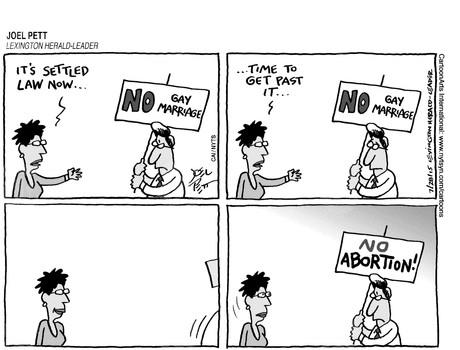
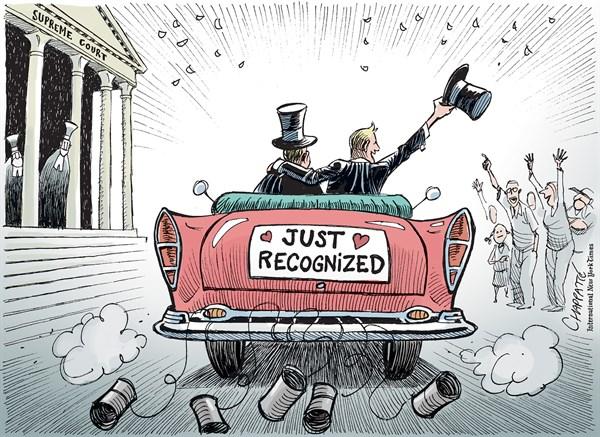
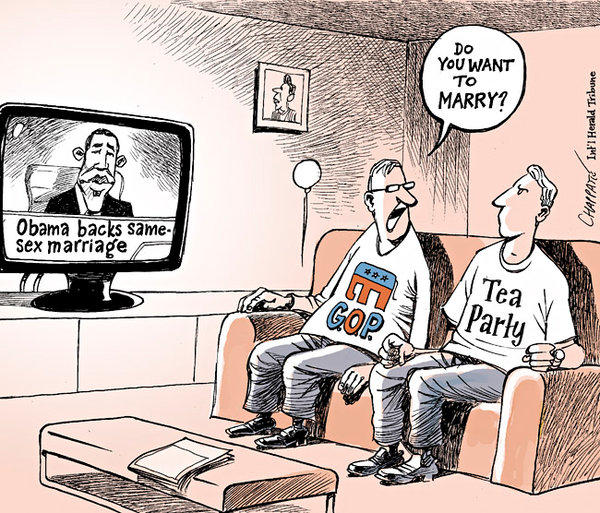
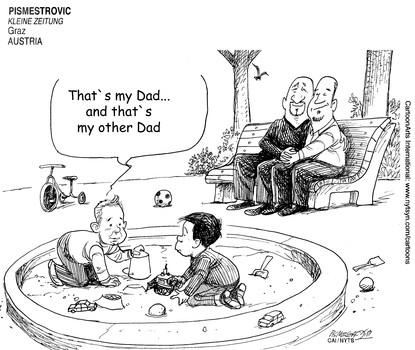
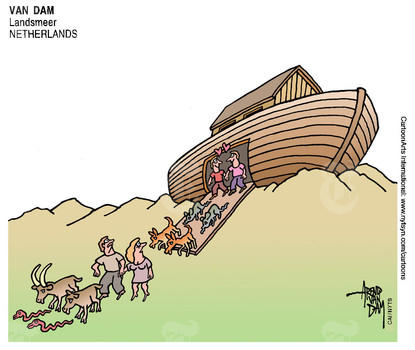
Works Cited
Andersson, Johan, et al. “Same Sex Marriage, Civil Rights Rhetoric, and the Ambivalent Politics of Christian Evangelicalism in New York City.” Sexualities, vol. 16, no. 3, 2013, pp. 1-14.
Jervis, Rick. “Same-Sex Marriage Ruling Faces Religious Rights Battle in Texas.” USA Today, 2015. Web.
Kelly, Amita. “Texas Supreme Court Rules against Benefits for Same-Sex Couples.” NPR, 2017. Web.
Kwakkel, Erik. “The Beauty of the Injured Book.” Medieval Fragments, 2014. Web.
Swartz, Omar. “Gay Rights/African American Rights: A Common Struggle for Social Justice.” Socialism and Democracy, vol. 29, no. 2, 2015, pp. 1-17.
Wilson, Robin. “Bargaining for Civil Rights: Lessons from Mrs. Murphy for Same-Sex Marriage and LGBT Rights.” Boston University Law Review, vol. 95, no. 3, 2015, pp. 1-18.